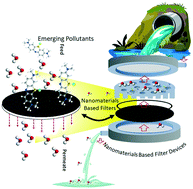Nanocomposite-based high-performance adsorptive water filters: recent advances, limitations, nanotoxicity and environmental implications
Abstract
Increase in global population and rapid industrialization are known to deteriorate water quality and cause severe water scarcity worldwide. In recent years, high-performance multifunctional nanomaterials with high specific surface area have been developed with a high degree of interaction with different pollutants. This is one of the most important aspects that influence the performance of nanomaterials in adsorption and photo-degradation processes. Various research groups have extensively studied the high-performance nanomaterials and nanocomposites of carbonaceous materials, biopolymers, proteinaceous materials, etc. for water filters. Such materials are robust adsorbents and successfully demonstrated as membrane materials. Thus, herein, high-performance nanomaterial-based functional materials which are demonstrated as efficient adsorbents and functional materials for permeable membranes with high rejection are reviewed. In particular, the development of simple and scalable water purification technologies has centred on multifunctional nanocomposite membrane-based water treatment devices. An attempt has also been made to highlight the disadvantages of nanomaterial-based filters, for instance nanotoxicity and environmental unfriendliness, that restrict the state-of-the-art nanocomposite-based devices towards commercial success.



 Please wait while we load your content...
Please wait while we load your content...